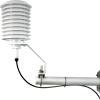This product is not available for new orders.

| Services Available | |
|---|---|
| Repair | Yes |
| Calibration | Yes |
| Free Support | Yes |
Overview
The HC2-S3-L, manufactured by Rotronic, is a rugged, accurate temperature and humidity probe that is ideal for long-term, unattended applications. The probe uses an advanced capacitive sensor to measure relative humidity. The probe includes a filter to protect the sensor from dust and particles, for superior performance and reliability.
Read MoreBenefits and Features
- Well-suited for long-term, unattended applications
- Accurate and rugged
- Compatible with most Campbell Scientific dataloggers
This product is available for repair and calibration
Images







Detailed Description
The HC2S3 comes with a polyethylene filter that protects its sensor from fine dust and particles and minimizes water absorption and retention. Alternatively, a Teflon filter is available for marine environments. The response time is slower when using the Teflon filter.
Compatibility
Please note: The following shows notable compatibility information. It is not a comprehensive list of all compatible products.
Data Loggers
| Compatible | Note | |
|---|---|---|
| 21X (retired) | ||
| CR10 (retired) | ||
| CR1000 (retired) | ||
| CR1000X (retired) | ||
| CR10X (retired) | ||
| CR200X (retired) | ||
| CR206X (retired) | ||
| CR23X (retired) | ||
| CR295X (retired) | ||
| CR3000 (retired) | ||
| CR500 (retired) | ||
| CR5000 (retired) | ||
| CR510 (retired) | ||
| CR800 (retired) | ||
| CR850 (retired) | ||
| CR9000 (retired) | ||
| CR9000X (retired) |
Additional Compatibility Information
Mounting
The HC2S3 should be housed in a 41003-5 10-plate naturally-aspirated solar radiation shield. This radiation shield mounts to a tripod or tower mast, crossarm, or user-supplied pole.
Specifications
| Electronics Operating Limits | -40° to +100°C |
| Storage Temperature Range | -50° to +100°C |
| Filter Description | Polyethylene (standard) or Teflon (optional, ordered separately) |
| Current Consumption |
|
| Supply Voltage | 5 to 24 Vdc |
| Startup Time |
1.5 s (typical) The startup time is a Rotronics specification. For programming, Campbell Scientific recommends a 2 s delay at 60°C, a 3 s delay at 0°C, and a 4 s delay at -40°C. |
| Maximum Startup Current | < 50 mA (for 2 μs) |
| Analog Outputs |
|
| Diameter | 15 mm (0.6 in.) |
| Length |
|
| Weight | 10 g (0.35 oz) |
Air Temperature |
|
| Sensor | PT100 RTD, IEC 751 1/3 Class B |
| Measurement Range |
-40° to +60°C (default) Air temperature measurement ranges from -50° to +100°C are possible; contact Campbell Scientific for more information. |
| Output Signal Range | 0 to 1 V |
| Accuracy | ±0.1°C with standard configuration settings (at 23°C) |
| Long-Term Stability | < 0.1°C/year |
| Sensor Time Constant - Standard PE Filter | ≤ 22 s (63% step change [1 m/s air flow at sensor]) |
| Sensor Time Constant - Optional Teflon Filter | ≤ 30 s (Typical 4 s, 63% of a step change [1 m/s air flow at sensor]) |
| Temperature Accuracy | Refer to graph in probe manual. |
Relative Humidity |
|
| Sensor | ROTRONIC® Hygromer IN-1 |
| Measurement Range | 0 to 100% RH (non-condensing) |
| Output Signal Range | 0 to 1 Vdc |
| Long-Term Stability | < 1% RH per year |
| Accuracy | ±0.8% RH with standard configuration settings (at 23°C) |
| Sensor Time Constant - Standard PE Filter | ≤ 22 s (63% of a 35 to 80% RH step change [1 m/s air flow at sensor]) |
| Sensor Time Constant - Optional Teflon Filter | ≤ 30 s (Typical 10 s, 63% of a 35 to 80% RH step change [1 m/s air flow at sensor]) |
| RH Accuracy over Temperature | Refer to graph in probe manual. |
Related Documents
Product Brochures
Articles and Press Releases
Newsletter Articles
FAQs for
Number of FAQs related to HC2-S3-L: 9
Expand AllCollapse All

